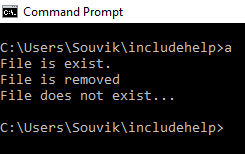C 中的 remove() 函数
remove() 函数定义在<stdio.h>头文件。
原型:
int remove(const char* filename);
参数: const char *filename
返回类型: int
函数的使用:
当我们处理文件时,有时我们需要擦除或删除一些文件。在文件处理中,我们使用 remove() 函数来擦除文件。函数 remove() 的原型是int remove(const char* filename);
这里,filename是必须删除的文件的名称。如果文件被成功删除,则返回零,如果发生错误则返回非零。
C 中的 remove() 示例
#include <stdio.h>
#include <stdlib.h>
int main()
{
FILE* f;
//Check the existence of that file
if ((f = fopen("includehelp.txt", "r")) == NULL) {
printf("File does not exist...\n");
}
else {
printf("File is exist.\n");
}
fclose(f);
//remove file
if (remove("includehelp.txt"))
printf("Remove error.....\n");
else
printf("File is removed\n");
//Check the existence of that file
if ((f = fopen("includehelp.txt", "r")) == NULL) {
printf("File does not exist...\n");
}
else {
printf("File is exist.\n");
}
fclose(f);
return 0;
}输出

相关用法
- C语言 rename()用法及代码示例
- C语言 rewind()用法及代码示例
- C语言 fread()用法及代码示例
- C语言 feof()用法及代码示例
- C语言 imagesize()用法及代码示例
- C语言 getarcoords()用法及代码示例
- C语言 strcspn()用法及代码示例
- C语言 setlinestyle()用法及代码示例
- C语言 showbits()用法及代码示例
- C语言 sprintf()用法及代码示例
- C语言 outtextxy()用法及代码示例
- C语言 isgraph()用法及代码示例
- C语言 grapherrormsg()用法及代码示例
- C语言 moveto()用法及代码示例
- C语言 putchar()用法及代码示例
- C语言 tmpnam()用法及代码示例
- C语言 putpixel()用法及代码示例
- C语言 fillellipse()用法及代码示例
- C语言 outtext()用法及代码示例
- C语言 atan2()用法及代码示例
注:本文由纯净天空筛选整理自Souvik Saha大神的英文原创作品 remove() function in C language with Example。非经特殊声明,原始代码版权归原作者所有,本译文未经允许或授权,请勿转载或复制。
